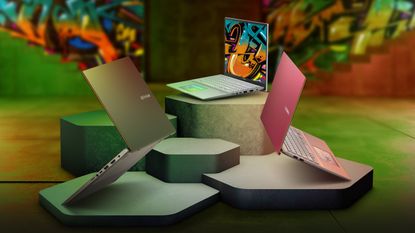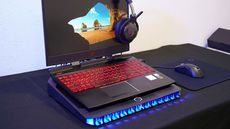There's plenty of great ultra light laptops for working on the go in 2023 with Intel's 13th generation processors taking on new offerings from AMD and Apple to make it a truly competitive year for laptop processors. There's still a few devices running 12th generation Intel processors and even an original Apple M1 chip in the mix here as we wait for the second half of 2023 laptop launches, but theT3's Aussie review team has managed to get its hands most of the top contenders so far – so this guide is all you’ll need to find the best laptop for any budget. It's regularly updated and expertly curated, so it'll lead you right to the best laptops for working, gaming, designing, studying and anything else.
Apple returns with a range of M2 silicone that offers improved performance and market leading battery life (especially in the higher performing MacBook Pros). That said Intel continues to throw additional cores at it's 2023 laptop processors that make them the highest performing processors in a number of laptop categories. AMD has returned to the fight this year too, with a Ryzen 9 processor that is topping the performance charts for our top gaming laptops.
If you’re specifically looking for something that can play the latest games, then you might want to check our best gaming laptop guide, and if you're a student who’s a little tight on cash then we also have a best laptops for students list.
You can often find good deals on the best laptops at outlets like Amazon or Dell, which means you might even be able to score these premium devices for a decent discount.
It's fair to say that the best laptop might be different for everyone, so we've covered a wide selection of system types, prices and designs here – no matter what your needs, you should find something that fits. If you’re after a specific type of laptop, however, you may want to dip into the following guides:
- Best lightweight laptops
- Best student laptops
- Best gaming laptops
- Best 2-in-1 laptops
- Best ultraportable laptops
The best laptops you can buy today
Why you can trust T3 Our expert reviewers spend hours testing and comparing products and services so you can choose the best for you. Find out more about how we test.


Unlike the MacBook Air range, the new MacBook Pro 14 and 16-inch laptops aren’t massively different to their predecessors. Obviously the devices come with new M2 Pro or M2 Max processors, which will bring respectable upgrades to overall performance, but other than this the devices only really get new Wi-Fi 6E networking capabilities, a new Thunderbolt spec, a faster AI chip and greater memory bandwidth.
This isn’t a complaint, the 14.2-inch or 16.2-inch Liquid Retina XDR displays are still top of their game with high 3K-plus pixel resolutions, bright 1000 nit sustained screen brightness, 120Hz dynamic refresh rates and full DCI-P3 colour reproduction capabilities.
The devices also offer industry leading SSD disk speed tests at 7700/5727 MB/s read and write speeds, respectively, and you’ve got a wide range of interface options including an HDMI and an SD Card reader, so you really don’t have to sacrifice anything.
One of the top line features of the 2023 MacBook Pros is a faster memory interface with greater bandwidth. Entry level 14 and 16 inch devices start at AU$3,199 and AU$3,999 respectively, but you can spec them up to $10K if you have an unusual need for storage and memory. Most people will have no need for more than the entry level devices, since they come with a M2 Pro chip, consisting of a 10 or 12-core CPU, 16 or 19-core GPU and a 16 Core Neural Engine; 16GB of Unified Memory; and a 512GB SSD. If we look at offerings from Razer and Dell these entry level units are by no means underpowered and offer competitive advantages over both the Blade 15 and XPS 15 devices.
This device's battery lasted over 20 hours in our 1080p movie playback benchmark. That’s well over what you’d really need for a remote work day and should include enough overhead to actually do some demanding creative work while on the go, which isn’t offered by other professional laptops on the market.
Read the full review: Apple MacBook Pro 16 (M2 Pro, 2023)


While the Dell XPS 15 misses out on the developments you’ll see on the XPS Plus 13 below, by using the existing XPS chassis Dell is able to pack in even more premium components while keeping the price down. This is by no means a compromise either since the cool carbon fibre clad chassis is sleek and functional.
The 14-core Intel i7-12700H CPU isn't too far off an update, but it outpaces Apple’s M1 Max processors in some benchmarks. This CPU is backed by a Nvidia GeForce RTX 3050 Ti GPU, 16GB of RAM, a 512GB SSD and a 1080p screen in the entry level configuration.
The RRP for this unit is AU$3,499, but interestingly we’ve seen solid discounts on equivalent models with a 3.5K OLED touch or 4K 500nit touchscreen displays that bring them down to around AU$3,000 direct from Dell, so it’s worth keeping an eye out for a discount.
This device offers 10 hours of 1080p movie playback and 12 hours-plus of light work -- still a long way off the 20 or so you'll get from Apple's latest devices, but a solid option against the rest of the Ultrabook offerings .
All of the configurations will be able to handle any workload you’ll throw at it and when paired with the 40W 3050 Ti you’ll get playable 30fps plus framerates on modern games, with 1080p Ultra settings.
The two higher resolution screens are some of the best available offering either a 3.5K OLED at 400 nits or an UltraHD display at a brighter 500 nit peak brightness.
Read the full review: Dell XPS 15 (9520)


"The MacBook Air (M1) is a small revolution. As much power as you could need in a light and silent design, with giant battery life." – T3's Apple MacBook Air review
As our MacBook Air (M1, 2020) review explains, Apple's cheapest laptop is the start of a revolution. Think thin and light laptops have to sacrifice power? Not any more. Or that big performance means smaller battery life? Nope. Or that getting all of these things in one machine would be expensive? Wrong again. This is the best of all worlds.
It's all thanks to the M1 processor – the first Apple-made chip for Macs. It's an eight-core chip that's as powerful as what you find in the high-end MacBook Pros or gaming PCs, but uses a fraction of the power. Combined with the fastest storage in the business, this laptop is fast. But it also runs cool enough that it doesn't need any fans at all, so it's silent.
It's even got pretty solid graphics performance, playing games far more smoothly than anything else with an integrated GPU (though, being a Mac, the selection is more limited). And it can give you around 15 hours of battery life in real-world use (for things like light browsing) – a huge leap over previous Macs.
Comfort and usability are top-notch too – the keyboard and trackpad are excellent, it's a great size and weight to be portable, and the all-aluminum build is solid and feels premium. The sharp screen is also a pleasure to use, with a good level of brightness.
It's a shame that it only has two USB-C ports (which also must be used to power it), since that means you'll probably need adapters, but maybe you're all in on wireless and cloud already anyway. There can also be some issues with software compatibility with the new processor, but these tend to only be with really niche stuff, so won't be a worry for the vast majority of people.
The base specs of 256GB storage and 8GB of RAM may also be too little for some people, but you can upgrade and customize when you buy (though you can't add more after purchase, we should note).
As long as you can live without Windows, the MacBook Air is a laptop that balances portability and power without compromises.


Dell’s XPS 13 has always been a leader in the ultra premium laptop market, but as the new Plus naming convention might give away, the new range of XPS 13 Plus devices are adding even more to the overall experience. Some of the update’s headline features include a notably more powerful Intel 12th generation CPU, an optional OLED touchscreen panel, a continuous glass touchpad/ palm rest and a neat capacitive touch bar.
The range starts at AU$2,599 and comes with a 13.4-inch FullHD display, a 12-core i5-1240P CPU, 16GB of RAM, and a 512GB SSD. The unit we tested came with a 400nit, 3.5K, OLED panel, an i7-1260P CPU, 32GB of RAM and a 1TB SSD with an RRP of AU$3,799, but it’s often on sale for around 20 percent less than that.
The Dell XPS 13 Plus i7 scored between seven and 12 percent better than the Late 2020 MacBook Pro 13 (M1), which puts it within 3 percent of the MacBook Air M2. Graphically Intel’s Iris Xe isn’t as advanced as Apple’s integrated GPU so the Dell XPS 13 Plus was 36 percent behind the MacBook Air M2 in the few cross platform games we tested.
Battery life also doesn’t look overly impressive next to Apple’s devices lasting just 6 hours and 6 minutes during 1080p movie playback, but it’s not too bad for a Windows Ultrabook.
The Gen 4 PCIe is as fast as any we’ve seen, capping out at 7,000MB/s Read and 5,000MB/s write speeds, and the quad speaker array is generous and compliments the capable screen in media playback. With a choice of Platinum or Graphite colouring, a HD webcam, a Windows Hello IR cam and dual microphone array, there really aren’t too many things wrong with the XPS 13 Plus.
Read the full review: Dell XPS 13 Plus

A 16-inch OLED Ultrabook with power to burn at an approachable price.
Asus’ Vivobook range has often catered to the more financially savvy premium ultrabook consumers, but the Vivobook Pro OLED series is looking to change this presumption with powerful thin and light offerings with OLED displays.
OLED screens are still not exactly commonplace on laptops, so we’re still surprised every time we see the colours they’re capable of reproducing and the Asus Vivobook Pro 16X OLED is one of the better OLED panels we’ve seen.
The 16-inch panel offers 4K resolution in a 16 by 10 format with Vesa True Black 500 HDR colour. While this is a pretty amazing feature set offering a 1-million-to-one contrast ratio, it actually sets the bar higher by meeting 100 percent of the DCI-P3 colour gamut and includes an unprecedented 0.2ms response rate on the 60Hz panel. This amounts to a generously sized display capable of accurate professional colour work and detailed creative workflows. It also looks pretty amazing for media playback and will bring to life any games you might want to fire up on it.
This impressive screen is backed up by one of the top AMD Ryzen 9 5900HX CPUs, a solid 16GB RAM allocation and a Nvidia GeForce RTX 3050 Ti GPU. That CPU was one of the best performing processors in 2021 and when paired with a 3050 Ti, this device offers above average Ultrabook performance that’ll be capable of running demanding software with ease.
When paired with a 1TB SSD the Vivobook Pro 16X OLED comes in at $3,199, which means it competes directly with devices like the Surface Studio Laptop and undercuts the MacBook Pro 16 (M1 Pro) by $550. In CPU heavy tasks it’s not quite where the MacBook Pro 16 is, but the 3050 Ti offers meaningful performance improvement over the M1 Pro 16-core GPU so it’s pretty comparable on the whole. If you do happen to want to game you’ll be able to get around 45fps using 1080p Ultra settings current titles.
The generous 96Wh battery offers over 10 hours and 30 minutes in general work tasks and media playback, which means you’ll get a full day unless you’re gaming or really stressing the system. This is an hour and a half more than what we got on the MacBook Pro 16 and is up there with the longest lasting laptops with high res screens that we have on file.
Asus has also invested a lot in additional features like a nifty DialPad for creative power users, a fingerprint reader, webcam shutter, low blue light software and a noise-cancelling microphone, to ensure you’re able to make the most of this device in any work environment.
There’s enough interface options and the trackpad and keyboard are comfortable to use, so we can’t see any reason why you wouldn’t want this laptop.

The Razer Blade 15 really isn’t just one device. You have a choice between four processors (spanning three generations), five graphics cards, four gaming screens, two RAM configurations, and two storage configurations – so the Blade 15 is really an entire range of laptops. This versatility, particularly in a screen type, is part of the reason why it’s frequently in the top spots of the best gaming roundups, but there’s another factor to consider: it’s extremely compact.
The Razer Blade 15 is as thin as the LG Gram 16-inch 2-in-1, and 100g lighter than a MacBook Air 16… even when configured with a Nvidia GeForce RTX 3080 Ti. Normally squeezing an enormous GPU like this into an Ultrabook form means you have to sacrifice a lot in performance. And on paper the 110W max power draw of the Blade 15’s 3080 Ti GPU seems a lot lower than the 165-175W power draws that bigger gaming rigs use to power this card, but the reality is that the performance gap is not as big as you’d expect here. The Blade 15 performed en-par in almost all GPU tests with the 165W 3080 Ti on a Asus ROG Zephyrus Duo 16. This means playable (40fps) frame rates on Cyberpunk 2077 using 1440p Ray Tracing Ultra settings and over 110 fps averages on less demanding games at 1080p Ultra.
Read the full review: Razer Blade 15 (2022)

The original Surface Laptop Go was an impressive budget-conscious device and the Surface Laptop Go 2 has made some major improvements to make it even better. It keeps the 12.4-inch PixelSense display, and offers a similar compact and ultralight profile, but has updated the processor, keyboard and storage options.
The new processor is 15-30 percent faster and the Gen 3 PCIe storage offers read and write speeds over 3000/1500 MB/s respectively. The device also offers a full work day battery lifespan, a fingerprint reader, and solid audio and web -conferencing capabilities.
Full review: Surface Laptop Go 2

The Zenbook Pro 16X OLED is Asus’s flagship creative workstation, blending an impressive screen with a unique raised keyboard, discrete GPU and generous battery for something that is really well suited to creative professionals.
The screen is undoubtedly the main drawcard here featuring a generous 16-inch 3840 x 2400 OLED display with an impressive 550nit peak brightness and full DCI-P3 gamut coverage for professional colour and cinematic work. This creator geared screen is supported by either an Intel Core i7-12700H CPU, Nvidia GeForce RTX 3060 GPU, 16GB of RAM and 512GB SSD; or an i9-13900H CPU, RTX 4070 GPU; 64GB of RAM and 1TB SSD. The latter here is really only for those needing a special kind of creative workstation for demanding cinematic or creative work since it comes with a price tag of AU$6,099.
The i7 model is also still expensive at close to $4K, but it’s more approachable for those wanting a little more power in their next laptop. It lines up pretty close to the MacBook Pro 16 range for those not convinced by Asus’ folding and dual screen laptop options and provides competitive screen specifications and power.
The battery life on the Zenbook Pro 16X OLED isn’t quite as good as the MacBook Pro’s, but it’s not far off with the 91Wh lasting longer than a work day performing standard office tasks. It’s also pretty close in terms of performance with around 15 percent better graphical capabilities and up to 10 percent lower CPU performance on some tasks.

Instead of offering a detachable tablet experience like the Surface Book, the Surface Laptop Studio has a screen that can fold into a drafting table shape to make it easy to draw on. The design (and title) is clearly borrowed from the company’s desktop all-in-one the Surface Studio and it works exceptionally well with the recently updated Surface Slim Pen 2.
The laptop has a recessed edge that we originally thought was to make the powerful 1.9cm device look a little less bulky in photos, but this unusual shadow line edge design actually creates an inverted shelf that can store the Slim Pen 2 and makes room for unimpeded thermal vents on either side. This does have the downside of constraining the space for ports so you’ll have to be content with a pair of Thunderbolt ports, the Surface Connect port and a 3.5mm audio jack.
The 14.4-inch PixelSense display looks really impressive, even when sitting next to an OLED display. Sure it’s a little more glossy and doesn’t have the same depth in the blacks, but the 2400 x 1600 pixel touchscreen has a 1500 to 1 contrast ratio and a vibrant 201 PPI pixel density. It only just scrapes in to achieve 100 percent sRGB colour reproduction though, so you can’t really use it for colour grading work, even if it does look great. It’s also a 120Hz display that makes the already responsive Surface Slim Pen 2 seem even more silky, and opens up interesting gaming potential when you pair it with the Nvidia GeForce RTX 3050Ti.
Battery life isn’t amazing at seven hours and four minutes of PCMark 10 Work benchmarks, and a little over six hours of movie playback, but it’s not horrible for an ultraportable with a discrete GPU.
You’ll get a similar laptop experience from the Asus VivoBook Pro 15 OLED for AU$2,299 if you don’t mind a three hour battery life, but there’s not really anywhere else you can get this kind of touchscreen and drawing interface.
Read the full review: Microsoft Surface Laptop Studio review
MSI has been making some good laptops of late, and the Prestige 14 Evo isn’t about to break that streak. Coming in at just 1.29kg the Prestige 14 EVO is on the lighter side of 13-inch laptops released in 2021. At first glance it might feel like it’s made out of cheaper materials but the sandblasted aluminium provides a sturdy shell that prevents any flex and helps keep it under 1.6cm thick.
There’s really only a couple of configurations available locally, with the top unit featuring an Intel Core i7-1280P CPU, 16GB of RAM and a 1TB SSD. This unit is one of the few to feature a 4th generation PCIe SSD, which means you can expect ridiculously fast read speeds of 4910MB/s… even if we could only get this one to 2508MB/s when writing.
Performance is on par with what you’ll see from the rest of the 12th generation P units here. This means it’s powerful enough to accommodate the workflows of most business users, with only designers and other creative pro’s needing a little more under the hood. As with everything here you also get the Iris Xe GPU gaming capabilities which means you’ll get playable frame rates for Low 1080p settings on many modern games.
Apart from the 4th-gen PCIe SSD the main drawcard of the MSI prestige is the price which is on the more affordable end without sacrificing on components. If you need a high-res screen you’ll have to look elsewhere, but everything else on this unit is top notch.
Read the full review: MSI Prestige 14” (2022)

A powerful workstation Ultrabook from Asus that is outstanding at both work and play.
The last couple of Zephyrus ultra-portable gaming laptops we’ve seen from Asus have been Built around AMD CPUs, so it’s interesting to see that the 2022 ROG Zephyrus M16 has an Intel processor kicking things off. There’s a major difference in Intel’s 12th gen, H series CPUs since they have 14 cores, rather than the eight cores you see on the 11th generation H series processors.
The ROG Zephyrus M16 is a refresh of Asus’ 2021 ROG Zephyrus M16 that sticks pretty close to its predecessor. It’s got a similar 16-inch display in a 15-inch form factor, with the same optional 16 by 10 QHD+ screen, wrapped in an almost identical 2kg chassis.
The updated 2022 Zephyrus M16 comes with either an Intel Core i7-12700H or an Intel Core i9-12900H processor. The former is paired with a 165Hz FullHD+ 16:10 display, 16GB of RAM and a choice of a Nvidia GeForce RTX 3050 Ti (100W) GPU for $2,799 or a RTX 3060 (120W) GPU for $3,199. If you opt for the i9 model, you’ll get that higher res 2560 x 1600 165Hz screen, a larger 32GB RAM allocation, and an RTX 3070 Ti (120W) GPU for $4,499.
For a reduced range, the configurations are pretty nicely balanced, even if we do wish that all of them got the QHD display. In addition to being higher resolution, the QHD+ display also offers a professional level DCI-P3 wide colour gamut for colour grading or high-fidelity HDR gaming, rather than the standard 100 percent sRGB colour on the 1200p monitors.
The metal chassis with ‘soft-touch’ coating gives a premium feel to the device and the generous trackpad, quiet keyboard, and subtle colour on the top shell continue a level of sophistication that is often missed on gaming laptops.
The Zephyrus M16 may be design conscious, but it’s also got good performance stats for a workstation ultraportable. The i9-12900H CPU model we tested was between two and 20 percent better than the average we currently have for a i7-12700H, although take this with a grain of salt since the i7-12700H performance can vary considerably. Regardless this powerful processor will be exceptional for any work or gaming tasks you throw at it.
The Nvidia RTX 3070 Ti GPU that we tested was allocated a 120W max power draw, which is a reasonable middle ground offering around 15 percent more performance than a 3070 Ti with a 95W TDP, but about 10-15 percent less than the same 3070 Ti offered on bulkier gaming laptops with 150W GPU power allocations. This translates to 90fps+ on modern titles using 1080p Ultra settings and around 60fps+ when using ray tracing or at higher resolutions. Expect about half this graphical performance if you opt for the 3050 Ti GPU or about 20 percent less for the 3060 GPU.
While battery life was improved thanks to the CPU, general work tasks and 1080p video won’t get you more than 3-4 hours respectively. The one main downside is that there’s been a $100 price increase from its predecessors on the low-end units and it’ll cost $1,100 more for the i9 model this year.
How to choose the right laptop for you

Make sure you consider your intended usage scenarios before pulling the trigger on a laptop upgrade.
We all have different requirements from our work laptop, and for many all that's critical is something to run your Chrome browser tabs and the Microsoft Office suite. If that's you, then you can get away with an 11th generation Intel Core i5, or can even go for something even lighter like a Chromebook. With most workflows operating in the cloud these days there's no need for most people to fork out for powerful Ultrabooks anymore.
If you do need to edit the odd photo in Photoshop, or you want to be able to take a look at your GoPro footage and do a bit of light editing for social media, then you'll want something with a little more power. Apple's M1, AMD's Ryzen 9 and Intel's Core i7-1165G7 processors will be more than enough to get you through just about every task you should expect to encounter, with a little left in the tank to future-proof it for the next few years.
11th Gen Intel i7 units, while the least powerful of these options, have been updated to be required to meet a set of minimum specifications to get Evo certification. To make the cut an Intel Evo Laptop needs to offer stable performance throughout its battery life, wake from sleep in less than a second, maintain over nine hours battery life on real-world use benchmarks, and offer four hours of battery life from a 30 minute fast-charge. These devices are also generally very portable at 1.5cm thick and a little over a kilogram for your average 13-incher.
If you are a visual creative you might opt for one of the 15-inch devices here, which will be a little heavier and thicker, but not by much. What is also neat about these bigger units is that most vendors include discrete GPUs with the bigger screen models, which will allow you to do some more heavy graphical lifting if you do any software development or visual effects work. These GPUs are even often capable of respectable FullHD gaming, which means you can get one device that'll do everything you need it to.
For anyone who wants something really lightweight there's even a number of impressively powerful tablets here that stand up to (or even outpace) some of the Ultrabook laptops. It's also worth noting that the premium price you once paid for these ultra-versatile devices isn't even that dramatic these days.











